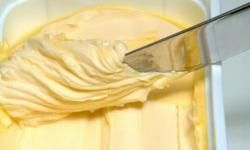 “Find out how to remove butter stains.JoLin
“Find out how to remove butter stains.JoLin
Knowing which side your bread is buttered on may help you avoid getting it on your shirt sleeve. However, if you are unlucky enough to forget where the butter is, remembering these tips will help you get rid of that greasy spot.
The first step in removing butter stains is to identify the stained material.
Below are the most common types of materials that can become butter-stained, with steps on how to remove butter from each:
- Non-washable fibers such as Acetate, Burlap, Carpet/Synthetic, Carpet/Wool, Fiberglass,Rayon, Rope, Silk, Triacetate, Wool
- Washable fibers such as Acrylic Fabric, Cotton, Linen, Modacrylic, Nylon, Olefin, Polyester, Spandex
- Hard surfaces such as Acrylic Plastic, Alabaster, Aluminum, Asphalt, Bamboo,Brass, Bronze, Cane, Ceramic Glass/Tile, Chromium,Copper, Cork, Enamel, Glass, Gold, Grout, lron, Linoleum, Marble, Paint/Gloss, Pewter Plexiglas,Polyurethane, Porcelain, Stainless Steel, Tin, Vinyl Clothing, Vinyl Tile, Vinyl Wallcovering, Zinc
- Stone surfaces such as Bluestone, Brick, Concrete, Flagstone, Granite,Limestone, Masonry Tile, Sandstone, Slate, Terrazzo
- Felt
- Leather or suede
- Paint/Flat or wallpaper
- Silver
- Wood
Contents
- Non-washable Fibers
- Washable Fibers
- Hard Surfaces
- Stone Surfaces
- Felt
- Leather or Suede
- Paint or Wallpaper
- Silver
- Wood
Non-washable Fibers
Follow these steps to remove butter stains from Acetate, Burlap, Fiberglass, Rayon, Rope, Silk, Triacetate, or Wool:
- Scrape (the method of using a scraping tool to gently lift off excess solid or caked-on stains) as much of the solid butter as you can without driving any of it further into the fibers.
- Apply an absorbent (cornmeal for light colors, fullers earth for darks), but do not press it in. Give the absorbent plenty of time to work.
- Remove the absorbent and if needed, repeat the application.
- If any residue remains, sponge (the method of using light strokes with a dampened pad working outward from the center of the stain) the spot with a cleaner, such as Afta Cleaning Fluid or K2r Spot Lifter (except on acetate blends).
Washable Fibers
Follow these steps to remove butter stains from Acrylic, Fabric, Cotton, Linen, Nylon, Olefin, Polyester, or Spandex:
- Scrape any excess.
- Pretreat (the method of applying a stain-removing agent directly to the stained area before laundering) with cleaner, such as Shout Liquid Laundry Stain Remover, blot the stained area, and launder as usual. If the stain remains, or if immediate laundering is impossible, place the fabric stainside down on an absorbent pad.
- Flush (the method of applying stain remover to loosen staining materials and residue from stain removers) with a cleaner, such asAfta Cleaning Fluid through the back of the stain and blot with a clean absorbent pad.
- Pretreat again and rinse well or launder.
Hard Surfaces
Follow these steps to remove blood stains from Acrylic Plastic, Aluminum, Asphalt, Brass, Bronze, Ceramic Glass/Tile, Chromium, Copper, Coral, Cork, Enamel, Glass, Gold, lron, Ivory, Jade, Linoleum, Opal, Paint/Flat, Paint/Gloss, Pearls, Pewter, Platinum, Plexiglas, Polyurethane, Porcelain, Stainless Steel, Tin, Vinyl Clothing, Vinyl Tile, Vinyl Wallcovering, or Zinc:
- Scrape to remove as much excess as possible.
- Wipe with a clean sponge or cloth dipped in warm sudsy water.
- Rinse with clear water and wipe dry.
Stone Surfaces
Follow these steps to remove butter stains from Bluestone, Brick, Concrete, Flagstone, Granite, Limestone, Masonry Tile, Sandstone, Slate or Terrazzo:
- Wipe up excess.
- Mix a solution of washing soda or detergent and water.
- Scrub any remaining stain.
- Rinse well and allow to dry.
Felt
Follow these steps to remove butter stains from felt:
- Scrape to remove excess, without forcing any butter further into the fibers.
- Dust the stain with an absorbent: cornmeal (for light colors) or fullers earth (for dark colors).
- Allow plenty of time for the grease to be absorbed.
- Gently brush (the method of using a stiff-bristled brush to gently remove dried stains and spots) absorbent off in the direction of the nap. If any stain remains, reapply fresh absorbent.
- Allow absorbent to work, then gently brush off.
Leather or Suede
Follow these steps to remove butter stains from leather or suede:
- Gently scrape to remove excess.
- Rub the stain with a thick paste of fullers earth and water.
- Let it dry and gently brush off the powder. Repeat if necessary, then, for leather only, apply products, such as Tannery Vintage Leather Cleaner & Conditioner or Fiebings Saddle Soap to condition the leather.
Paint or Wallpaper
Follow these steps to remove butter stains from paint or wallpaper:
- Scrape to remove excess.
- Rub the stain with a suede stone. Or, make a thick paste of fullers earth (on dark surfaces) or cornmeal (on light surfaces) and press the paste onto the stain with the palm of your hand.
- Allow to dry, then carefully brush off with a clean cloth.
Silver
Follow these steps to remove butter stains from silver:
- Wash silver in hot soapy water.
- Rinse in hot water and wipe dry immediately with a clean soft cloth.
Wood
Follow these steps to remove butter stains from wood:
- Wipe up excess with a clean dry cloth.
- Dip a cloth into warm sudsy water and wipe away any greasy residue. Rinse well and polish or wax.







































